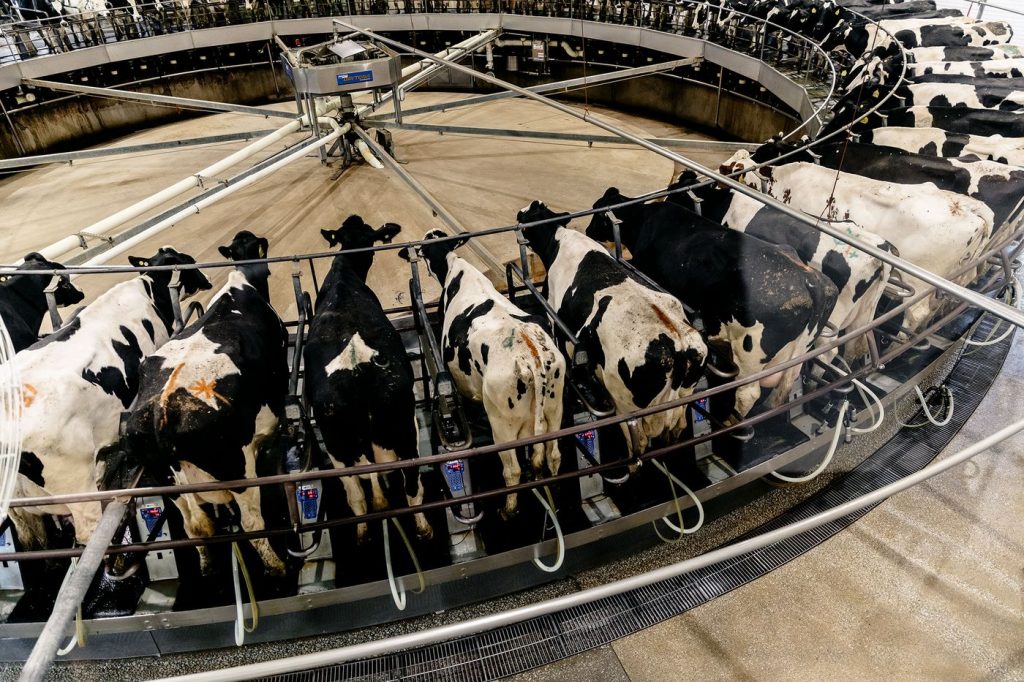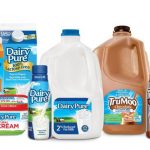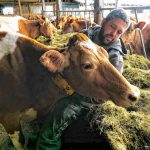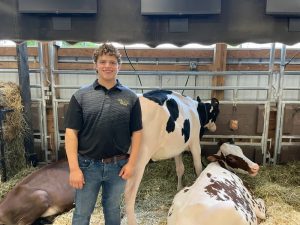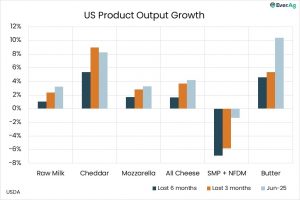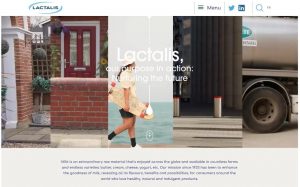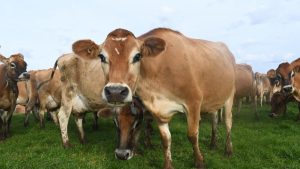
To lure drivers off Interstate 65 at Exit 220, about 70 miles southeast of Chicago, the roadside ads lean hard on wordplay. A metal corncob the size of a speedboat carries the words, VISIT EAR OFTEN! A sign with a cow on it promises A DAIRY GOOD TIME FOR THE FAMILY! Another billboard shows a wide-eyed kid with a fruit-flavored ice cream in his hand: BERRY TEMPTING!
You’re in for even more of this sort of thing if you take the exit. At the BP gas station, the little food market inside is called the Dairycattessen. There’s Central Bark, a green area to let your dogs run around in, and an adjacent Cowfé where you can get cheese sandwiches and milkshakes. The water tower is mottled like a Holstein, but just about every other structure in sight conforms to the red-and-white motif of the classic American barnyard. Among them is a hotel with two towerlike extensions painted to resemble grain silos and an indoor pool with a slide that looks like a big wet cow’s tongue. These attractions, however, are for later, after you visit another barnlike building two doors down. On its face, big white letters in a Playskool-esque font announce: YOUR ADVENTURE STARTS HERE.
This is Fair Oaks Farms, an Indiana tourist attraction designed to entertain road-weary families and deliver them back to the highway reassured that American agriculture is headed in the right direction. With more than 33,000 cows that pump out some 300,000 gallons of milk daily, it’s also quite a bit more. “Welcome to our home, a functioning Modern farm, where our Animals are the center, led by a team with country Charm,” says a sign by the counter where you buy tickets for the tour. “There’s nothing here that’s hidden…. Everything here is from the heart. If you’re ready for Ag-venture, Fair Oaks Farms is the place to start.”
The grounds are immaculate, and if you’re in the mood to celebrate milk—“the most wholesome food on earth,” according to the recorded script that’s broadcast on the bus tour—you’ll probably love it as much as Cargill Inc., Land O’Lakes Inc., and other corporate partners apparently do. But outside of these 19 acres, in much of the rest of rural America, dairy hasn’t been celebrated much in recent years. Instead, it’s been agonized over, lamented, even eulogized.
In Wisconsin alone, between two and three family dairy farms go out of business every single day. (Some of these farms still operate, but no longer as dairies.) That rate has held steady for about three years, which is particularly striking given how few farms remain left to fail. In the early 1970s, the state had more than 75,000 dairies. Today it has about 7,400.
Across the western border in Minnesota, officials recently reported that the median household income rose last year to about $68,000, roughly 10% higher than the national average. Dairy farmers had nothing to do with it. In 2017, the median income for a dairy farm dipped just shy of $44,000 in the state. In 2018, it plunged all the way down to $14,697. Half of Minnesota’s dairy farmers failed to break even for the year. There, too, thousands of dairy farms have simply vanished.
In the midst of this mass extinction, a counterintuitive fact remains true: Americans are consuming more dairy products than ever before, primarily because yogurt and cheese have compensated for a steady drop in fluid milk consumption. Americans consumed 646 pounds of dairy per person in 2018—the highest consumption rate in 56 years.
As small farms fold, the balance of production tilts further toward huge, efficient, industrial dairy operations that can more easily weather price downturns and manage a razor-thin profit margin through the power of scale. Places, in other words, like Fair Oaks Farms.
“Thirty years ago, when I got started, if you would have asked me what a large farm was, I probably would have said 15 or 20 cows, something like that,” says Mark Stephenson, the director at the University of Wisconsin Center for Dairy Profitability. Now a concentrated animal feeding operation—a CAFO, as factory-style farms like Fair Oaks are known—can house thousands or even tens of thousands of cows. Today, more than 53% of America’s milk is produced by less than 3% of its farms. That helps explain how, in the face of a massive reduction in the number of total dairies, the U.S. continues to produce more milk and cheese than the market consumes—in 2019, America’s cheese surplus reached 1.4 billion pounds.
“People still have this image of red barns, of cows in the field,” Stephenson says. “We’ve all been there—it’s an image, and it feels like a warm hug, somehow, and that’s what you want to think of when you think of a dairy farm. But that’s not the reality anymore.”
Everywhere you look at Fair Oaks, you’ll find something that imitates, if not exaggerates, the precise strain of countrified charm that industrial agriculture is often blamed for destroying. It makes a direct and unabashed attempt to tap into those warm-hug feelings with facsimiles of the homespun and pastoral, while at the same time celebrating the efficiencies that come from the advances that replaced them. The tour guides plug a notion that at times contradicts the imagery: Industrial-scale dairies may be quantitatively and qualitatively better than small, traditional, family-operated ones—for consumers, for the environment, and even for the cows.
Mike and Sue McCloskey, the founders of Fair Oaks, are close to royalty in the dairy industry. Mike started his career as a veterinarian in California and eventually became a partner in dairy farms there and in New Mexico. After spending several years as the chief executive officer of Select Milk Producers Inc., one of the largest and most powerful dairy cooperatives in the country, he moved with Sue to Indiana in the late 1990s.
Share of U.S. Dairy Operations by Cow Herd Size
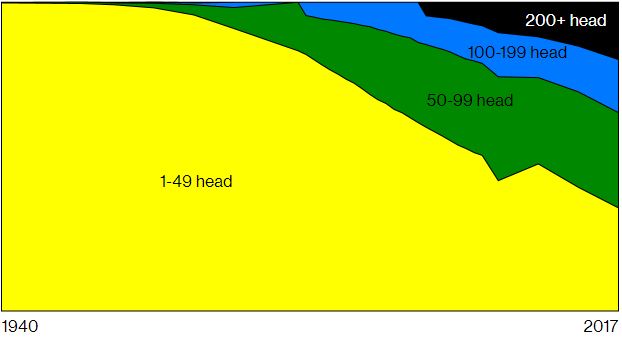
Data: U.S. Department of Agriculture
Industrial-scale operations had already thoroughly transformed the meat and poultry industries, and dairy was poised to follow suit. The business model faced a predictable obstacle, however: the generalized perception that large-scale farming was bad for just about everything except productivity and profitability. Fair Oaks, the McCloskeys announced, would directly and transparently confront those they labeled the “anti” activists—animal-rights groups and environmental campaigners.
“The farm was founded out of necessity to counter the very loud, very well-funded, and often, very misleading voices against modern farming and animal agriculture in particular,” said Sue McCloskey in an interview with Food & Wine in 2018. “Having come from a non-generational farming background”—that’s another way of saying she doesn’t come from a family of farmers—“and growing up in the consumer-centric East Coast, I knew the ploy of these organizations.”
In an introductory video shown to tourists at Fair Oaks, Sue is seen mingling with her “girls,” the cows. The animals spend almost all of their time in barns or, if they’re calves, inside small plastic hutches. To preempt the idea that they’d rather be grazing in open pastures, the informational materials emphasize that the sheltered cows are freed from the ravages of wind, rain, and extreme temperatures. Tourists are driven through a barn-turned-exhibit, where, from behind the windows of a bus, they can watch a few hundred cows lying hip-to-hip in metal-railed stalls. A recording playing over the bus’s sound system assures visitors that there’s no better place for cows to be than here, where they’re free to eat, drink, and socialize. “They love to hang out at the drinking fountain and interact with other cows in the herd,” the recording says.
The tour also touts the environmental benefits delivered by this style of containment. One display says an operation like Fair Oaks uses 90% less land and 65% less water than dairy farms once did to produce a gallon of milk. Some of that can be attributed to selective breeding managed through artificial insemination, and also to nutritional supplements; the average dairy cow today produces more than four times as much milk per year as she did in 1950, and today’s most productive heifers pump out 14 times more.
The centerpiece of the farm’s story of environmental sustainability, though, is its anaerobic manure digesters—large tanks in which waste is heated and turned and the methane produced by the process is captured. A typical dairy cow produces about 120 pounds of waste every day; multiply that by 30-odd thousand, and let your imagination fill in the details of that picture. On the farms of old, where cows roamed and grazed, manure management wasn’t much of a problem; it nourished the same grass the cows ate. In a typical industrial-scale farm, manure is dumped into pits and lagoons, and the resulting methane releases into the atmosphere. Because the gas has an atmospheric impact 25 times greater than carbon dioxide, according to the Environmental Protection Agency, it effectively accounts for 10% of all U.S. greenhouse gas emissions. Dairy cattle alone are responsible for 53% of methane emissions generated by manure, the EPA says.
Fair Oaks Farms’ four digesters help the operation reduce its emissions while also producing compressed natural gas, which fuels the operation’s trucks and provides electricity to the barns. Fair Oaks casts it as an elegant solution, and the system has been widely lauded as a model that one day could result in a dairy with net zero carbon emissions. But some critics complain that such digesters fuel a harmful cycle. The government grants millions of dollars to large farms every year to build digesters (Fair Oaks received federal and state funding for its system), which reinforces the methods that created the problem in the first place.
Last year a Florida man named Richard Couto read about the Fair Oaks tour and decided to fly to Indiana to check it out. He was, to say the least, skeptical of the benefits the farm advertised—Couto is founder of the Animal Recovery Mission, or ARM, which launches what it calls tactical missions to expose animal cruelty. “I took the Dairy Adventure tour, and I knew right away I was being lied to,” he says. “I knew it was staged.”
Couto wanted to see everything that wasn’t showcased on the tour, the other 90% or so of the operation. His way in, he determined, was through the labor force. As in most CAFO-style dairies, many of the jobs are both low-paying and physically demanding—the kind often filled by immigrant laborers. (More than half of all dairy workers in the U.S. are immigrants, according to a 2015 study by Texas A&M University.) Couto sent people to Indiana to apply for jobs at Fair Oaks, and they were quickly hired. One began clandestinely filming his co-workers. For nearly three months he compiled footage, until someone at the farm figured out what he was doing and tipped off the McCloskeys, Couto says.
The couple released a video statement on social media in April, informing the public that activists had infiltrated their operation to “misrepresent our practices and [what] we are about,” Mike McCloskey said.
If the message was meant to preempt whatever backlash might arise from an eventual video release, it didn’t work. In early June, ARM posted videos that showed Fair Oaks workers dragging calves by their ears from vehicles, tossing them through the air into plastic enclosures and transport trailers, and beating them in the heads with milk bottles and branding irons. Dozens of examples chronicling multiple forms of abuse were exposed. Protests against Fair Oaks were staged in Chicago and elsewhere. Some targeted the Coca-Cola Co., which was partnering with Fair Oaks and Select Milk Producers, where Mike McCloskey is still CEO, to produce the Fairlife brand of premium milk. In its marketing push for that product, Coca-Cola advertised that the milk was sourced from family-run farms that pursue “the highest standards of milk quality, agricultural sustainability, and animal comfort.” Lawsuits were filed alleging fraud. Late last year eight of those suits were consolidated into a single consumer-fraud case. Milk from Fair Oaks Farms is no longer being used in Fairlife products.
The farm announced that the employees who could be identified in the video had been fired, and said it would post cameras throughout the farm, hire a new animal-welfare supervisor, and implement frequent animal-care audits. The McCloskeys released more videos promising that animal care was a top priority and pledged that their commitment to total transparency would be stronger than ever.
After numerous requests over the course of several months, before and after the release of the ARM video, Fair Oaks and the McCloskeys declined to be interviewed for this article. The tours continue as before, however, and dairy industry groups accuse the activists, in effect, of provoking a few bad apples among the farm’s workforce into bad behavior. The trade organization Dairy Management Inc. has stood by Fair Oaks as a model for the evolving industry. “Big is not bad,” says Marilyn Hershey, the group’s chair.
Mike Yager smooths a copy of his latest federal milk check on a table in his equipment barn and studies the numbers. The U.S. Department of Agriculture regulates and controls the complex pricing schemes that put money in the farmers’ pockets. The milk check lists all of the factors—price differentials, premiums earned, deductions—that together determine how much money Yager gets each month. One of the deductions listed on the check in front of him, a figure that last year averaged about $1,000 a month, is for advertising and marketing. It’s a mandatory deduction that helps fund groups such as Dairy Management Inc. That line item irritates Yager every time he looks at it; sometimes, he says, it seems like the industry he helps support is promoting trends that put his way of life in jeopardy.
His farm in Mineral Point, Wis., sits in the Driftless Area, a part of the upper Midwest that wasn’t ironed flat by glaciers during the last ice age and is defined by its rolling hills. Not so long ago, with 300 cows, his farm would have been considered reasonably large. Now he considers himself one of the little guys, barely managing to stay afloat.
The price of milk is determined by a complicated government framework that, generally speaking, has insulated the industry from volatile ups and downs. But in recent decades, even with state and federal buffers, the price of milk—both what farmers receive and what consumers pay—has lagged behind inflation. This is part of a general drop in the relative price of grocery staples; since the 1960s, the percentage of income Americans spend on food has fallen by roughly half. As the dairy industry has shifted to large farms, and production has continued to outpace demand, profit margins have grown increasingly tight. This has put a squeeze on everyone in the industry, including the major companies that depend on smaller farms for supply. In November, Dean Foods, America’s largest milk producer, filed for bankruptcy; in January, Borden Dairy, founded in 1857, did the same.
Last fall, Yager attended the World Dairy Expo in Madison, Wis., where industry leaders floated plans to help dairy farming thrive. There was a lot of talk about the new U.S.-Mexico-Canada Agreement, or USMCA, which allows American producers access to an estimated 3.6% of the Canadian market, up from the previous limit of 1%. The plan, which was signed into law in January, didn’t impress Yager. “Canada’s dairy industry, total, is about $18 billion, and the state of Wisconsin alone is about $45 billion,” he says. “So this 3.6% that the government is talking about? This number that’s supposed to be a big deal? It’s peanuts. It’s nothing.”
At that same expo, some attendees began talking about the threat of laboratory-made, animal-free milk—the dairy industry’s answer to the meatless burger. Big agriculture companies including Archer Daniels Midland Co. have invested in projects to use cellular cultures to produce dairy proteins. Yager was incredulous. “The major corporations that have made their money off the farmer are putting their money back in, reinvesting, to put us out of business!” he says. Later, at the same event, U.S. Secretary of Agriculture Sonny Perdue talked to reporters about the consolidations that have troubled so many farmers. “Now, what we see, obviously, is economies of scale having happened in America—big get bigger, and small go out,” Perdue said. “I don’t think in America we, for any small business, have a guaranteed income or a guaranteed probability of survival.” Maybe he was just stating a hard truth, but to a farmer like Yager, it sounded as if the architects of the U.S. dairy industry had all but agreed on a shared assumption: Small farms are destined, sooner or later, to fail.
The stress farmers end up feeling, however, is rarely associated with these sorts of big-picture discussions. The challenges are always hyperlocal, and they often trigger a circular pattern of collapse. First the farmers struggle to make ends meet, then the related businesses that help populate small towns and townships—the seed wholesalers, the equipment dealers, the trucking companies—respond to a dwindling customer base by raising prices where they can. In the end, the hardship circles right back to the farmers.
One day last year, the bearings went out in one of the axles of Yager’s manure spreader. No big deal. He drove to the local equipment dealer, who charged him $165 for new bearings. Six months later, the bearings on the other axle went out. Again: no tragedy. But this time the same dealer charged him $310 for the same service. The ad hoc inflation would be forgivable if it didn’t seem like it was compounded every single day. Yager sells most of his milk to a local cheese processor, and in 2016 he paid the processor $4,800 to truck his milk from the farm to the processing plant. Last year, for the same service and for roughly the same amount of milk, the processor charged him more than $38,000.
Crazy, you might say, and—save a choice word or two—you’d be echoing Yager’s thoughts exactly. In 2019 he considered taking out a loan, buying a big truck, and shipping the milk to his processor himself. But when the processor realized farmers were willing to resort to such measures, it started levying a surcharge on all farmers who trucked their own milk. Other local processors did the same.
“Every time you come up with a plan to maybe make things better, I just feel like there’s someone who’s already a step ahead of you,” Yager says. “So what do you do?”
A lot of people go out of business.
In the summer of 2019, about a dozen farm-loan officers, equipment dealers, manure storage technicians, and other agricultural professionals filed into a conference room in a county building in West Bend, Wis. They’d signed up for a half-day workshop designed to help them respond to dairy consolidation in their communities.
The programs bore titles such as “Embracing Option B” and “Making the Connection: Communicating With Distressed Farmers.” An instructor briefed them on the basics of mindfulness meditation, the differences between empathy and sympathy, and how to use EARS (Explore, Affirm, Reflect, Summarize) when talking to a troubled farmer. As the attendees took notes from a slide showing “Tips to Take Back to the Barn,” the instructor asked how many of them had encountered farmers who’d exhibited worrying signs of depression. Every one of them raised a hand.
Milk Price Received by Farmers
Per 100 pounds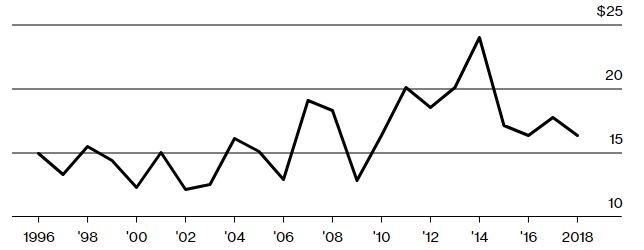 Data: U.S. Department of Agriculture
Data: U.S. Department of Agriculture
In dairy-producing communities nationwide, local agriculture extension offices are launching programs to encourage stressed farmers to try new ventures. Wisconsin’s agriculture department, for one, provides farmers with information about how they might transition farms into bed and breakfasts, petting zoos, or farm-to-table restaurants.
Mention these ideas to farmers and other agricultural professionals, and chances are fair you’ll witness a roll of the eyes. Jerry Gander, who helps manage herd nutrition for farmers across the state, including Yager, shakes his head in disbelief. “I mean, come on. Really? They really think we’re going to sustain this region with a bunch of bed and breakfasts?”
Gander, just by expressing his doubts out loud, seems to tap a deep reservoir of frustration. “There’s got to be something other than saying, ‘Well, you have to be big to survive,’ ” he says. “Maybe this is getting a little radical, but it reminds me of medieval times. Like we’re going back to that. We’ll have our kings—the owners, the corporations—and then we’ll have all the people who work the land. That didn’t work well centuries ago. Because taking ownership, taking pride—that’s what makes things really work. We’re gonna lose that. And think about conservation. Think about water quality. I don’t think you find land conservation, water quality, and animal care any better, anywhere in the world, than you do on these family farms. You absolutely will not!”
He stops himself, apologizing for getting carried away. “It’s just that these are big cultural questions we’re gonna have to deal with, and we’re stuck right on the forefront of it. People in town, they just don’t have any comprehension,” Gander continues. “We’re gonna watch our schools disappear. Our governments disappear. Our roads fail. That’s a coming thing. It’s not just B.S.”
Amid all that angst, some farmers have found a way to profit on smallness itself.
Paul Aubertine grew up on a plot of land overlooking the St. Lawrence River on the northern edge of New York state, near Cape Vincent. He was poised to be the seventh generation of his family to take the reins of the 50-cow dairy farm, but in 2002 his father and grandfather determined they couldn’t keep the business afloat any longer. Aubertine went to college, pursued a career in sales, and started a family.
The older he got, the more he recognized and valued all that had been lost. There’d been 35 or 40 dairies in the community when he was growing up; now, wracking his brain, he could come up with four. “I really wanted my kids to experience what I’d experienced, to give them the chance to grow up on a farm and be exposed to the same thing,” he says.
He and his brother-in-law, a computer scientist, decided in 2015 to restart the dairy. They crunched the numbers and saw that trying to compete with the 1,000-cow mega-dairies on their terms was a recipe for disaster. “I’ve never had an interest in having employees, and $300,000 tractors, and all the other stuff you need for that,” says Aubertine, who’s now 37. Instead, they decided to produce milk that could be certified as grass-fed and organic. Their cows would graze in the field. Aubertine would buy no herbicides, no grain feed, no nutritional supplements, no hormone treatments. Instead of acquiring the huge, high-powered heifers that produce 90 pounds of milk a day, he assembled a herd of smaller cows that might give him 35. Because of the animals’ reduced stress, he could keep them on the farm longer, saving on livestock costs.
“I’m a realist, and I expected bumps on the road, but—and I shouldn’t say this out loud, probably—but it’s been beyond my expectations, what we’ve been able to do,” Aubertine says. The price he commands for grass-fed organic milk isn’t double that of regular milk, but it’s close, and his expenses are a fraction of what a modern dairy would require. He can raise his kids, take them on vacations, buy nice things, and preserve precisely the things about dairy farming that he believed were worth preserving.
“It’s not even so much the prices you’re paid, but it’s the consistency of the prices,” he says. “We can make a budget, because we know what we’re going to be paid—we’re guaranteed each month’s prices a year in advance, and they don’t come off that price, unless they go up and pay more. So I’m not one of those dairy farmers going to the mailbox every month and worrying about what’s going to be in the milk check.”
He sells to Maple Hill Creamery LLC, a venture-capital-backed company specializing in organic milk from grass-fed cows. It collects milk from 158 farms, all in upstate New York. The average farm keeps 48 cows. CEO Carl Gerlach says he believes increasing demand for milk from grass-fed cows has the potential to transform the American dairy farm. “When I think of what dairy will look like in 20 years,” he says, “I believe it’ll look like it did 100 years ago.”
If that transition actually occurs, Aubertine knows it’s unlikely to be a smooth one for farmers currently operating within the standard, modern dairy system. Aubertine’s organic certifications—the ones that enable him to get premium prices—require that his land, for example, has been free of herbicides and synthetic fertilizers for at least three years. “If that’s what your farm is running on, how is a farmer going to just stop doing that for three years, and still keep his head above water?” he asks. “So we were kind of lucky, in a way. It’s easier to start from scratch.”
When dairy cows no longer pay for themselves, they’re often culled—the polite term for being sent to slaughter. As small farms fold, their cows are rarely incorporated into the herds of large dairies; older animals don’t handle the transition to a new milking system well and produce less milk than those raised in the system. According to industry figures, only four times in the 25 years before 2019 did the national weekly total of slaughtered dairy cows exceed 70,000. Every one of those times occurred in the second week of January, when slaughterhouses reopen after a holiday hiatus and catch up on a backlog of work. In 2019 it was a rare week when the cull total didn’t exceed 70,000.
Yager, on his farm in Wisconsin, watched his nephew try to sell off his cows last fall. “Anything that was over four years old, people didn’t want,” he says. “He had to haul them out to be culled.” The very thought pained him. “I know every one of my cows,” he says. “I love these animals.”
On a winter weekday morning at Fair Oaks Farms, a traffic light outside the Birthing Barn, a red-painted structure near the Cowfé, turns green. That means another show is about to commence inside. About 30 people gather on bleachers in an amphitheater-style room. Two cows stand onstage, separated from the crowd by a glass wall. Jumbo TV monitors hang above them. The backside of one cow faces the audience; extending from it is a small, glistening hoof. The cow, breathing heavily, convulses slightly. The hoof extends further, exposing a foreleg. “Ewwwww!” a little girl in the crowd says. “Is that a baby pig coming out?”
Within minutes—at 11:48 a.m., precisely—a Fair Oaks employee tugs hard on the calf’s protruding legs, and with one final push from its mother the animal falls in a messy heap on the straw-covered stage. It’s one of about 80 to 100 calves born that day, and every day, at Fair Oaks.
After the mother licks the calf awake, the newborn is ushered offstage and outfitted with an ID tag: 36,873. —With Deena Shanker and Lydia Mulvany
